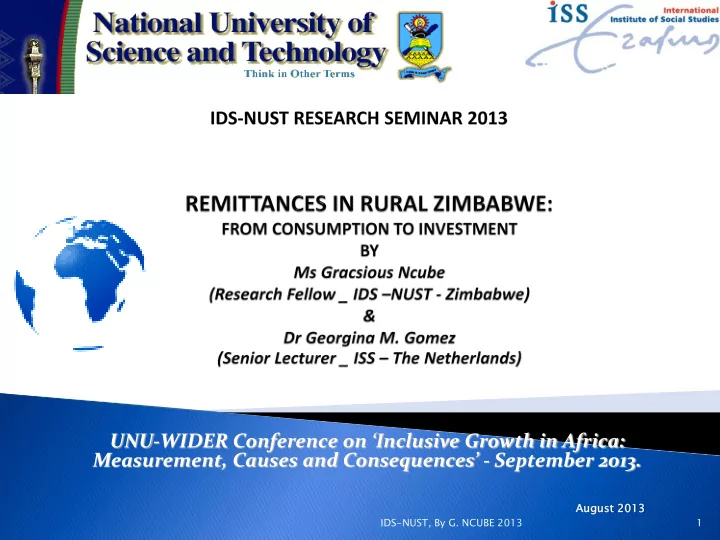

UNU-WIDER Conference on ‘Inclusive Growth in Africa: Measurement, Causes and Consequences’ - September 2013. Aug ugus ust 2013 2013 IDS-NUST, By G. NCUBE 2013 1
INTRODU DUCTION RES RESEA EARCH RCH QU QUES ESTI TIONS METHODO DOLOGY REM REMITTA TTANCES & LD LD – AN OVE OVERVI RVIEW FINDIN INGS CONC NCLUSI SIONS NS RECOMME MMEND NDATIO IONS IDS-NUST, By G. NCUBE 2013 2
Migration: major global development issue. Many effects of emigration & remittances one of the main noted benefits. Remittances vs Cooperation aid Remittances have considerable development impacts based on HH focused methodologies Missing = analysis of longer term effects on local economies. Remittances in Zimbabwe = for consumption & less on investment(Maphosa 2007; Tevera and Zinyama 2002). IDS-NUST, By G. NCUBE 2013 3
Benefits focus on the short-term effects & recipient HHs = unit of analysis. Long-term effects not focused on (local economies) Methodological focus should be on local economies than households (De Haas 2006) Main argument = remittances contribute to local development in ward 2, Tsholotsho district in diverse ways. IDS-NUST, By G. NCUBE 2013 4
Do receiving households use remittances for consumption or investment; What kind of investments do remittances promote in the local economy of Tsholotsho district? How do these remittances impact on local development? IDS-NUST, By G. NCUBE 2013 5
Study area = village 2 in Tsholotsho district Mix ixed ed qualit litativ ive metho methods ds Ethnographic technique – ‘FOLLOW LLOW THE THE MON MONEY’ EY’ (Adaptation of C. Moser’s Livelihoods Vulnerability Framework) Interviews - key informants & entrepreneurs Household survey IDS-NUST, By G. NCUBE 2013 6
Vulnerability Outcome of Type of Outcome Context Crisis Solution of Solution Agric. • Food shortages • Increased income • Increased drought • Increased productivity spells consumption (natural LO LOCAL L • Loss of income (availability of capital) (unproductive sector) alternatives) DEVEL ELOPMEN ENT Educ. & Health • Children drop out • Increased school from school enrolment (Human • High outbreak of • Increase in health capital) illness conditions (PHC) • Loss of decent • Improvement of Infrastructure housing i.e. housing by building (physical unavailability of modern structures capital) • Improved access thatching grass due to low rainfall. to transport • Dilapidated road • Availability of networks resulting in alternative transport shortages transport Growth Oriented Investment enterprise Gender • Increased workload • Improvement in for women women’s practical Inequalities (practical gender gender needs (social capital) needs worsened) En Enterp rpri rise Survivalist creati tion enterprise 7
Con onsumpt ptio ion: complete utilisation of all the funds remitted on daily consumables Inv nvestme stment nt: money that was not consumed immediately but rather used on acquiring non-consumables that could be profitable in future Local cal De Deve velopm pment: enterprise creation, employment creation, increased agricultural productivity & infrastructure improvement IDS-NUST, By G. NCUBE 2013 8
Diverse effects on development Infrastructure development & investment in the long run. Increased consumption in receiving HHs (Health, education &family welfare) Sub-saharan Africa – remittances invested in real estate = provision of housing IDS-NUST, By G. NCUBE 2013 9
Lack of other investment instruments No sound economic policies to promote stable economic growth Optimistic vs Pessimistic views Unrealistic to expect remittances to promote LD where complimentary infrastructure, services and ecological conditions are not favourable (Grabel 2009; Maimbo & Ratha 2005; Taylor et al 1996) IDS-NUST, By G. NCUBE 2013 10
IDS-NUST, By G. NCUBE 2013 11
¾ of HHs have migrated members Seasonality of remittance flows – highest amounts when migrant visits & in December. Both cash & in-kind received through omalayitsha Modern H n Housing ng In-kind = food, clothes, building material, furniture Trad aditional Gr Gras ass Stru ruct cture re Cash range from ZAR 150 – 2000, average ZAR500 Thatch hatched ed H Huts Remittances major source of income (purchase food, clothing, education, healt, agric inputs, building brick under asbestos/zinc housing structures) Boost HHs’ asset bases that sustain them in shock eventualities (scotchcarts, bicycles, generators, solar panels, livestock) which increase their income generation Community Dev projects (e.g. Dam construction & Clinic) Clin Clinic IDS-NUST, By G. NCUBE 2013 12
Non-receiving HHs benefit indirectly through the ripple effect. Develop innovative strategies to rip off some benefits of remittances Therefore, receiving HHs form consumptive middle class that absorbs labour from non-receiving counterparts. IDS-NUST, By G. NCUBE 2013 13
Remittances = LD reflected by employment creation, investment in small enterprises, increased agricultural prod. & infrastructure development. Less than 10% of receiving HHs venture into GD, Butch tcher ery & & Bottl ttle Fillin ling S Station ion investment in terms of enterprises. sto tore Infrastructure improvements = improved housing structures, financing community clinics and dam construction Remittances wield a ripple effect on local economy Trigger entrepreneurial ventures from people based outside the locality. Promote agricultural productivity and growth Grin rinding M Mill ill IDS-NUST, By G. NCUBE 2013 14
Employment creation = shop keepers High incidence of maids & herd boys Brick moulding = temporal self imposed employment Seasonal and /or temporal employment for the non-receiving HHs especially in Agric. IDS-NUST, By G. NCUBE 2013 15
Remittances flow through informal channels Remittances = mainstay of economic activity in study area Contribute to LD through promoting productive consumption which attracts investment (ripple effect). Promote LD through investment in enterprise creation, agricultural productivity & infrastructure improvements & income generation. IDS-NUST, By G. NCUBE 2013 16
Actors in development to promote availability of other investment instruments Policy makers to coil economic policies that promote stable economic growth Local authorities to ensure availability of complimentary infrastructure and services favourable to promoting impact of remittances on LD Further research on the sustainability of the resultant enteprises. IDS-NUST, By G. NCUBE 2013 17
IDS-NUST, By G. NCUBE 2013 18
Recommend
More recommend